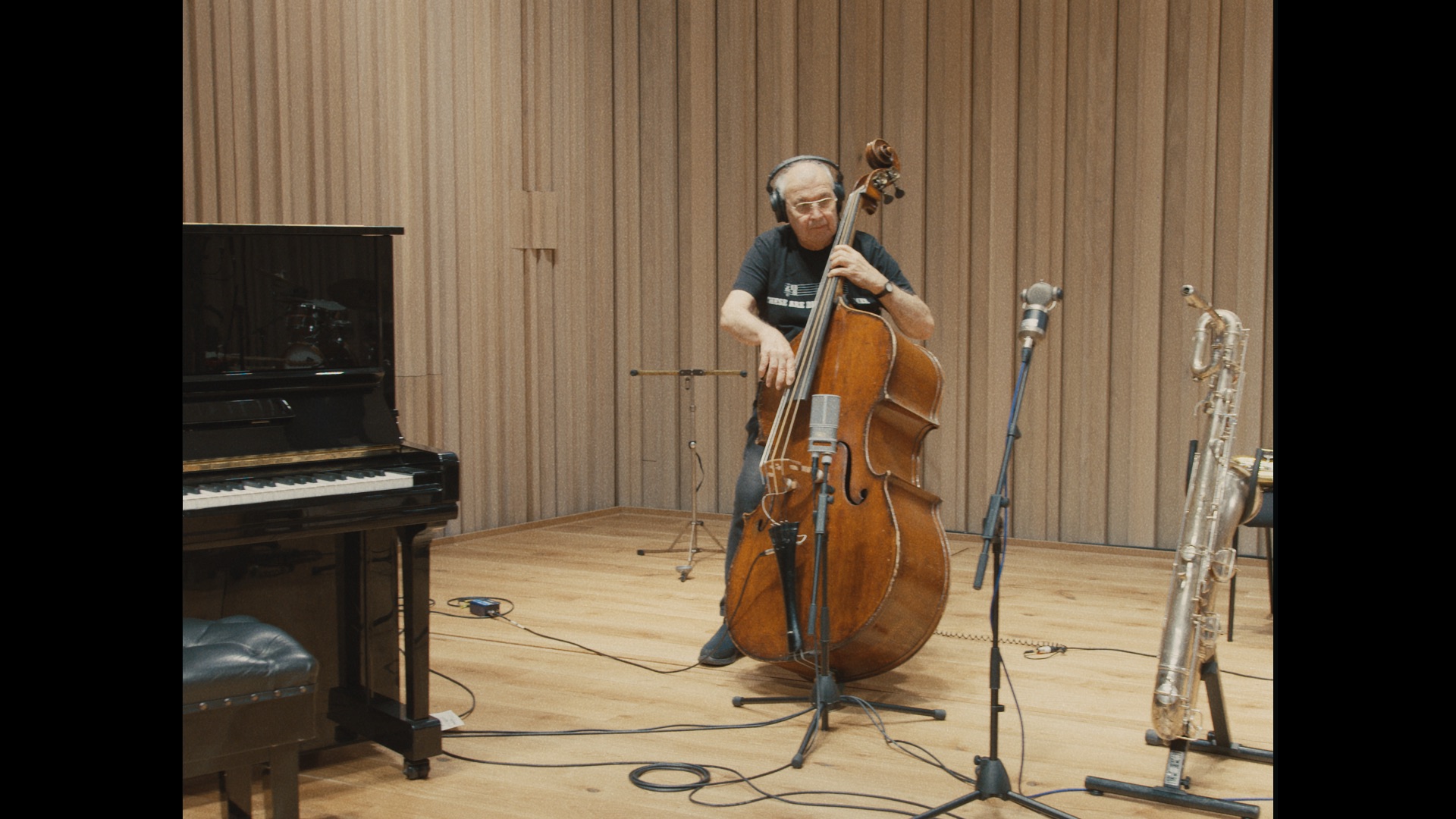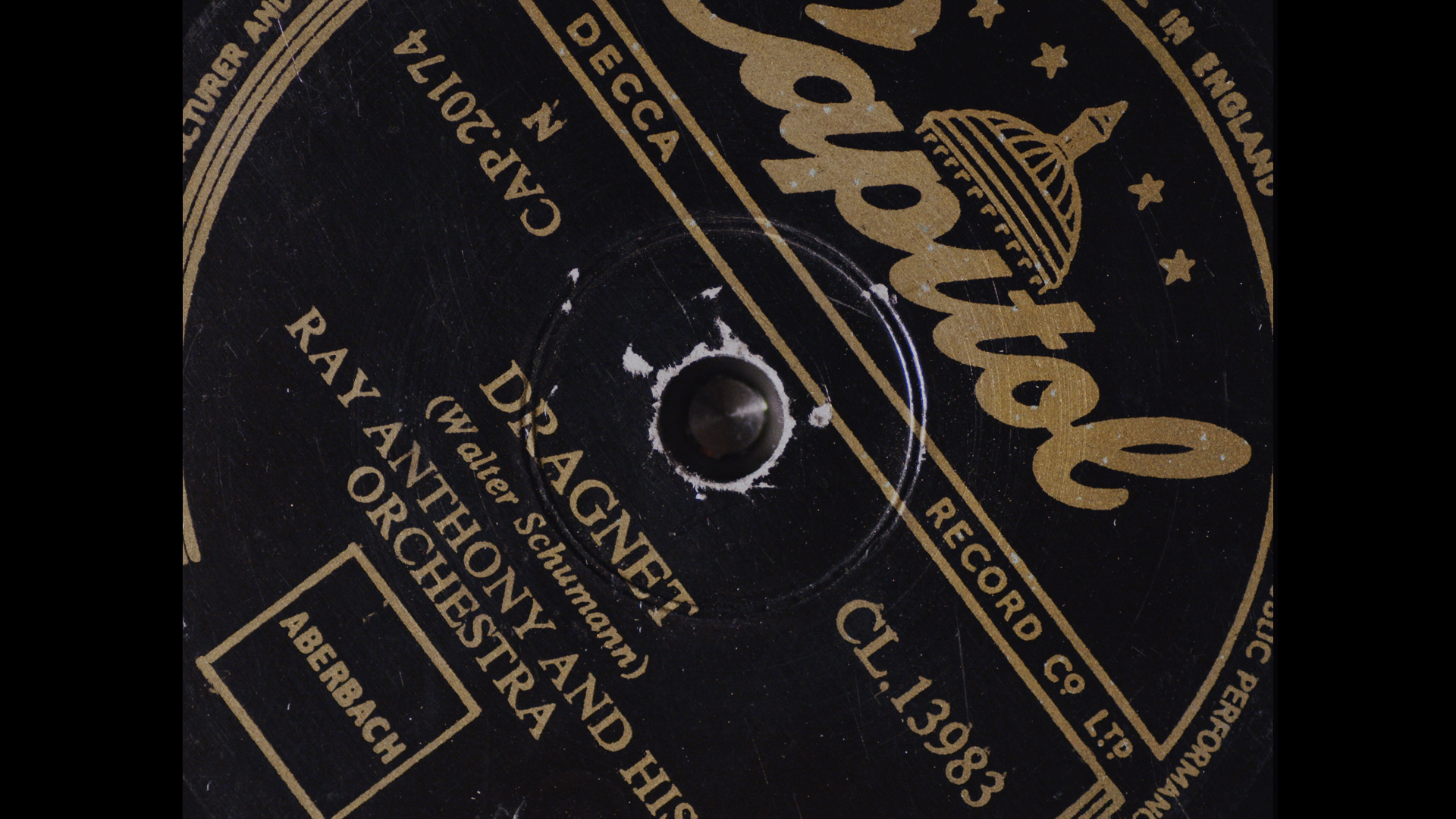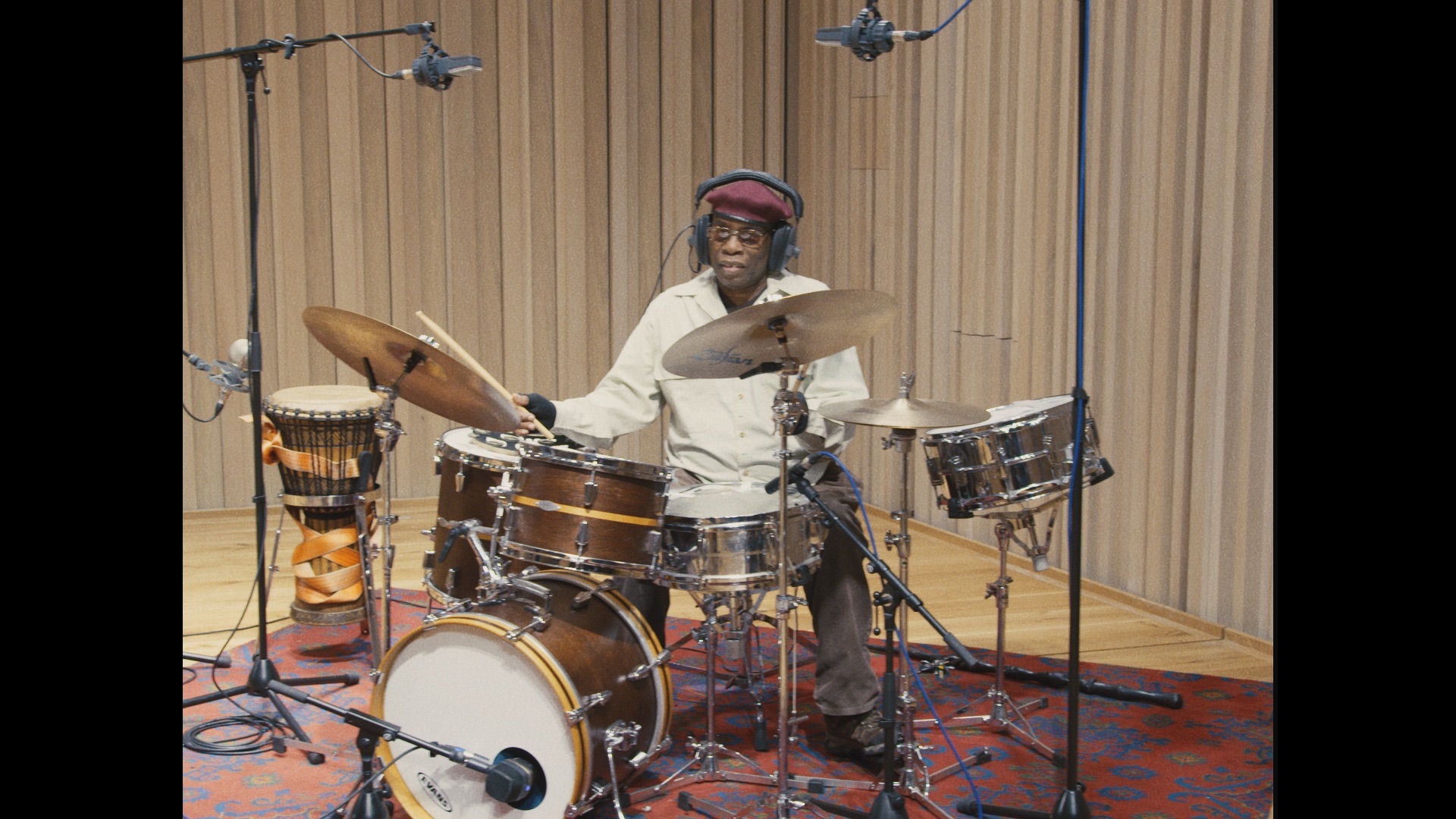Radical archiving, parallel universes and déjà entendu
Ellen O'Donohue Oddy
This interview with Open Music Archive explores collective cultural consciousness and pop music.
Projects
Watch Everything I Have Is Yours by Open Music Archive in full here
The clue is in the name with Open Music Archive — the artist collective made up of Eileen Simpson and Ben White — who work within the parameters of expired copyright material to collect, digitise and share music available for public use, and repurpose them within their art practice. I meet them in early summer to discuss their latest work Everything I Have Is Yours, which opens in Salford Museum and Art Gallery — a fitting location for this Manchester-born duo. For the making of Everything I Have Is Yours they kept it homegrown too, working with a group of musicians who were either active or growing up in the Manchester music scene during the period of 1952-1962, a decade that is historically, legally and culturally symbolic. Marking the beginning of the UK charts, 1952 was the first year a top 10 existed in the UK — “in fact, it was a top 12 in 1952,” Ben remarks, “still in the old imperial system.” Meanwhile 1962 is the last year, at current, where recorded material exists within the public domain due to recent copyright laws that shifted the length of ownership, meaning materials in 1963 won’t be available in the public domain until 2034. Whilst this period of music has its own theoretical power in terms of music law and methods of production, it also offers a lifeline between today’s hyper-virtual online music communities and the generation of sounds that were triggered 60 years ago.
“This period became really interesting in terms of its particular sonic qualities,” Ben explains. “It’s before the golden era of pop music. Before multi-track recording, before the Beatles, there were these specific, very saturated recordings, which were really redolent of a particular period; they have a sonic trigger within them that recalls certain times and certain moments. Steve Goodman calls it ‘déjà entendu’ or the already-heard; you hear a sound that you can’t quite place, but it has specific resonances which recall something, jolt you into a particular moment. I don’t think you had to have been there in the sixties or lived through that period in order to get that sense, because this material is imbued in culture, these sounds percolate through other recordings and samples, in films and in various different places. They reappear across our collective cultural consciousness, and so are recognisable for someone born in the nineties, as part of our collective past.”
This notion of déjà entendu creates a dual context for music listening and archival work, where the traces of past music that exist within contemporary music become a psychological trigger into collective memory. What is unusual about Ben’s claim is that these sounds from the past are not necessarily chosen by contemporary artists through sampling, cover versions or parody. Instead these sounds naturally, almost uncontrollably seep into our collective consciousness through an organic lineage of time. It is a strange power dynamic, where the exchange of archival sound is a fundamental element of contemporary music, as well as a determination of contemporary musicians. Yet it is because of this strange exchange between archive and contemporary sounds that the idea of déjà entendu exists; sounds bring forth a spectre of a memory, a feeling that we have no control over, a confusion between present and past reality. As Eileen articulates, such a process is “an unearthing of an archival sound, and it has its own energy in that way.”

In Everything I Have Is Yours, musicians gather in what appears to be a rehearsal space and play out samples from records of this era. A tracking shot curves from one end of the room until it runs out and the viewer is jolted back to the beginning, in rhythm with the time signature of sonic loops which have been remastered and resampled from the original hits of the fifties and early sixties. This perpetual sonic loop that always shifts us back to a new start obscures every moment that went before, and whatever is yet to come. In some ways, déjà entendu is mimicked by the structure of the piece, because time is at odds in this film, and as viewers we feel we are in multiple places at once. “With déjà vu you’re not actually remembering something that’s happened to you previously,” Ben clarifies, “it’s a rift in the way that you’re processing time. In a way that feeling of dyschronia, that split in time that’s happening for us, it’s not that we’re remembering the fifties — it’s a mixing up of time.”
The film therefore is playing with memory as a space between our own personal fictions and realities through a rewiring of archival sounds, which in turn exposes those sounds as being both part of our undeniable present, and part of our imaginative past. The film claims that the music of the past is alive, its content traceable in contemporary sounds; a symptom, perhaps, of a temporal rift in our cultural consciousness. This tension between the musical past and present is what Mark Fisher, repurposing a concept initiated by Jacques Derrida, named ‘hauntology’: ‘the classic sound, its elements now serenely liberated from the pressures of historical becoming, can now be periodically buffed up by new technology [...] this dyschronia, this temporal disjuncture ought to feel uncanny, yet the predominance of what [Simon] Reynolds calls ‘retromania’ means that it has lost an unheimlich charge: anachronism is now taken for granted.’ (1) For Fisher, we are stuck in time, unable to distinguish between present or past sounds. The musical forms of the past haunt in a way that is so imbued within our modern musical output that we cannot place where they are in contemporary sounds, nor trace them back to its origins.
Fisher was concerned with the inertia of contemporary musical form rather than the sonic lifetime of particular melodies, yet his theory on hauntology is still an interesting counterpoint to Eileen and Ben, who purchased hundreds of shellac and vinyl records from eBay and discogs, digitised them, and made a film out of it; placing the viewer in the midst of Fisher’s hauntological landscape through sonic content rather than form. Through remixing and sampling, the melodic moments of the past appear as the sounds of the present: “we were zooming in at the level of code and thinking about how we could take the record as a dataset,” Eileen explains. They used computational processes to dissect the recordings into individual sounds, and siphoned them off into chords, breaths and drums because, as Ben makes sure to distinguish, “it is the sound of the record that is in the public domain, rather than the composition.” These now individualised ‘sonic events’, as Ben calls them, were then repurposed to build new, strange loops, which were workshopped with the group of musicians over a duration of months.
The final piece is not a culmination of all these experiments into a song, performance, or album, but rather a documentation of their improvisational process and its ongoing sonic moments. Eileen elucidates on this. “The timeline for this film features many takes of one track, and the singer or drummer will move in the space of one track, so that visually you’re seeing different snapshots of different moments. We wanted to add to the sense of this being in construction rather than being completed.” To sustain this notion of incomplete practice and rehearsal, when it came to the editing suite, Eileen and Ben had to stick strictly to the form of the original loop made, and build upon that. Ben continues this train of thought. “Because we were using these out-of-copyright loops as a driver for all their performances, everything was structured around these archival loops. It was a vertical edit where everything was stacked on top of and locked to the loop.” You can sense this in the work, which at 30 minutes in length is densely layered, both repetitive and regenerating, and resists completion or fullness. Eileen conceptualises this as “the momentum of the film, which comes together in a rhythm that is endless and ongoing, where the camera doesn’t wait for people to be ready. The momentum of the loop is the activating force that resurrects the archive and builds into something, but then collapses, but then continues.” I think about this space created by the film, between complete and incomplete, between past and present, at the centre of dyschronia. The viewer, I suggest to them both, is being placed in multiple parallel universes. Eileen expands on this: “Because of the endlessly looping shot in the room, there’s endless possibilities of ways that you could put the edits together. This fragmentary compendium of sounds and images is fixed into one scenario but there could be endless other possibilities. That looping structure has several layers and reasons for existing in that way.” By working with archive material that already exists in our collective cultural consciousness, but then dissecting and remaking that sonic material into a sound that isn’t unique but ongoing and relentlessly repetitious, Eileen and Ben are igniting an archive as a present energy that has multiple, co-existing universes across time. Yet throughout the film and across its multiple start and end points, there is a deliberate and impactful presence of the archive — not as its transformed self, but in its original form.
Eileen and Ben never allow us to forget that these sounds are traceable within one specific era, and in this way they develop Mark Fisher’s ‘anachronism taken for granted’. Each song is restarted by the visual of the vinyl, and each sound is played by a musician or sounded by a singer, who was part of the ‘original teenager’ generation. Eileen articulates this choice as something more than just symbolic: “we wanted to take the notion of dyschronia a step further and work with people who have experienced those sounds, the original sounds.’

The archive is both resurrected and preserved because the two main subjects of the camera, and the two creators of the sound, are the musician and the record. “We see two spaces,” explains Ben, “we see the musicians playing within this rehearsal- recording space, which is intercut with shots of shellac and vinyl records — the source material of the loops that are being constantly assembled and reassembled by the musicians. The cutaway to this macro shot of the vinyl is a visual analogue of the process of recording or sampling from the archive. As you see the record move in relation to the length of the sample, there’s a visual locking into and out of the archive.” The musician and the record are in constant call and response, and the camera looks at every moment where the archive is picked up, repurposed, lost and then re-found. By not moving the camera’s eye away from anything but the source sound that we hear, and editing within the densely organised loops, Eileen and Ben create a film about sonic archives, lost memory and experimental interpretation that radically resists loss.
The musicians and the vinyl are not just a visual nod to a bygone era; each moment the camera spends with these subjects tell the stories beneath the sounds. Ben mentions how “no one speaks in the film, and stories of the individual musicians are not communicated through the voice, as part of a historic or anecdotal narrative. Instead the stories are embedded within the archival sound and, furthermore, the sound played by the musicians. And they are recalling those sounds through their interaction with the archive, but they are also recalling those riffs and melodies and words from a muscle memory, their own archival bodies, and their lived experience.” The shots of the vinyl and the paper covers offer something very similar, what Eileen names “a one-to-one experience, a closeness, a texture, basically a moment where you might remember or recall, from a handwritten title of a track. I was also thinking about the sound of that paper, the material qualities of that. What would be the sonic equivalent of a pan across the paper where you see the grain? That physical nature of the archive? The way that it might feel if you were to drag your hand across it?” Both the musicians and the records tell the stories of the past through their visual presence, and reveal that we are listening to a sound that is not of today’s making. The bodies of the musicians and the grain of the sleeve paper are like the crackle of the vinyl as it plays across digital radio airwaves, making us aware, as Mark Fisher describes, ‘that we are listening to a time that is out of joint’; (2) except that in this case are being received through the prism of video, as well as sound. Everything I Have Is Yours breaks down the wall between archive and the new, the past and the present, by working with not only the material, but the people who lived, created and played through both time frames. It places its viewers within a sense of dyschronia, but in the disrupture of time, the repetitive loop and its parallel moments, we also have this connection of the living musicians, a clean line from the past and the present, pulling everything together.
“There was never a band,” Eileen maintains. Instead there is a group of individuals coming together, bringing their personal histories to the fore. Open Music Archive is the collective name that unites Eileen and Ben, but it is also a methodology of practice, one that resists wholeness, resists completeness, resists the end. One that is committed to the ever-present and the always-used, that finds consistency within change. They do not see archives as lost materials, waiting to be dusted off and repurposed into the new. Instead, they are shining a light on where these archives live and breathe in today’s world. The experience of watching Everything I Have Is Yours is not looking nostalgically at a photo album from your past, it’s looking at the kitchen you have lived in for years and feeling all your memories coalesce at once.
1 · Mark Fisher, Ghosts of My Life: Writings on Depression, Hauntology and Lost Futures, 2014, Zero Books, p. 11, 14
2 · Ibid. p. 21.
–––
Ellen O’Donohue Oddy is a writer based in London and Communications Manager at FVU. Her work explores the overlaps of form in post-modern and contemporary art, literature and music. She has previously conducted writing workshops at the Barbican and performed her poetry at Tate Modern.
This text was written in response to Everything I Have is Yours (2019) by Eileen Simpson and Ben White (Open Music Archive), which was commissioned by Film and Video Umbrella, Contemporary Art Society, University of Salford Art Collection and Castlefield Gallery. Presented by Contemporary Art Society, Mbili Foundation and the University of Salford.

_2019_(cc)_by-sa_4.0_1.jpg)